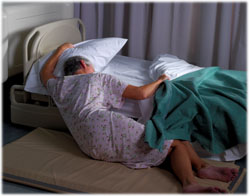In the Ergonomics in Design section of OPC’s Blogs we talk about the use of Ergonomics and Human Factor Design in the prevention of accidents & human error. To take this theme further, discussion about how the design of the SYSTEMS including product/equipment and technology, process/procedures and the building design and environment affects the frequency and severity of human error and accidents.
Following is a review of one of the most important accidents which occurs in all health care settings every single day across North America; patient falls.
Preventing patient falls is a major emphasis for many health care facilities today and for all in patient Physiotherapists who deal with the outcomes of these falls in their practice. Patient falls are well studied by the CPA, OPA and National HealthCare forums as these often lead to patient death or serious disablement
Extensive research finds there are many factors that contribute to patient falls. Some of those factors are environmental, technological, training, work process & procedure related as well as design related. Here is a partial list of the contributing and causative factors:
- Overall layout of the room
- Flooring surface (type, pattern, color, texture)
- Lighting levels, placement & reflectance
- Furniture type-bed, chair, wheelchair, tables, computers
- Furniture location within the room
- Patient physical ability
- Patient mental ability
- Walk space/clearance
- Patient transfer equipment
- Staff to patient ratio
- The workplace systems, methods, standard operating procedures & culture
The goal of Ergonomics and Human Factors Design is to fit the job demands to the health care provider and the patient.
Ergonomics and Human Factors means the caregivers and patients’ physical and mental abilities are taken into account when considering the design of all of the listed aspects listed above. How these factors interact with each other and with the patient determine whether or not a fall will occur as well as the seriousness of the fall. Here is a more detailed look at these factors;
Overall layout of the room: The layout of the room will determine where patients mostly likely will walk and move about the room. The location of the bed in relation to all other parts of the room is important to consider for traffic flow (caregivers, patient, family members, visitors) for inclusion of necessary furniture and equipment within the room.
Flooring surface: Common flooring considerations include the type of surface, i.e. carpet vs. hard surface, and its coefficient of friction. The pattern, texture & colours of the floor can impact people’s vision which could lead them to lose their balance.
Lighting: The amount of lighting, nature of the lighting, use of contrast and placement of lighting affects how easy it is to see the path and any obstacles.
Furniture Type: Considers if/how the design, function and use of the hospital bed, side chair, wheelchair, room hardware, computer contributes to a person’s tendency to fall. The design of the chair, i.e. seat depth and contour of the back of the chair for example could contribute to patients slouching and sliding down out of the chair.
Furniture Location: Hospital and nursing home rooms can become full of furniture, machines and items that prevent a clear path from the bed to the bathroom. This can be hazardous to the patient as well as to the caregivers who have to move or work around furniture to provide cares to the patient.
Walk space/clearance: The general size of the room, hallway or area and the amount of furniture, cords, and other items in the space can create a hazard.
Patient transfer equipment: Facilities that have safe patient handling programs will have different types of equipment to choose from for moving and handling patients. The selection of the proper equipment and accessory item followed by the correct use of the equipment are vital in preventing patient falls and injuries.
Staffing ratios: It may be easy to think that when the ratio of staff to patients is high that the number of patient falls should be low. However, sometimes it’s not the number that’s important but it is the next item that has the greatest effect on patient care which is…
Workplace System including work flow, policies, procedures, training and supervision: The responsibilities and activities of all of the caregivers that provide patient care to the patient are very important in preventing falls. The system in which caregivers perform their jobs (task assignment, rounds, patient hand-offs, integration of non-nursing departments, integrated teams.) greatly affects patient care, quality and satisfaction.
The design of the workflow system has to consider several human factors in order to prevent errors in medications, prevent effects from fatigue and prevent effects from rushing and/or complacency.
A breakdown in each and combinations of the above can result in patient falls. However, a proactive systems approach using Ergonomics and Human Factors design in the physical design of the environment, the evaluation and selection of the proper furniture, hardware and equipment and in the process design of staffing and caregiver roles and responsibilities will reduce the risk for patient falls.
All too frequently when a patient fall occurs the investigation which follows typically results in assigning blame onto the caregiver. It’s easy to say that the caregiver didn’t use the equipment in place or did not use if properly; the bed alarm wasn’t set; the caregiver didn’t take into account the patient’s medications etc.
Assigning blame to the caregiver (called human error) does not lead to learning about the root cause for the falls and does not look at the entire system design of products/equipment, process and environment involved in which the caregiver acted.
A full audit following a fall will help the Ergonomist
JESleeth C DeMaeyer Ergonomic Consultants OPC Inc



THank you so very much for your kind comment. Let us know if there are some case studies you have which we can talk about on our Blog. Wishing you well in your endeavours. Jane Sleeth